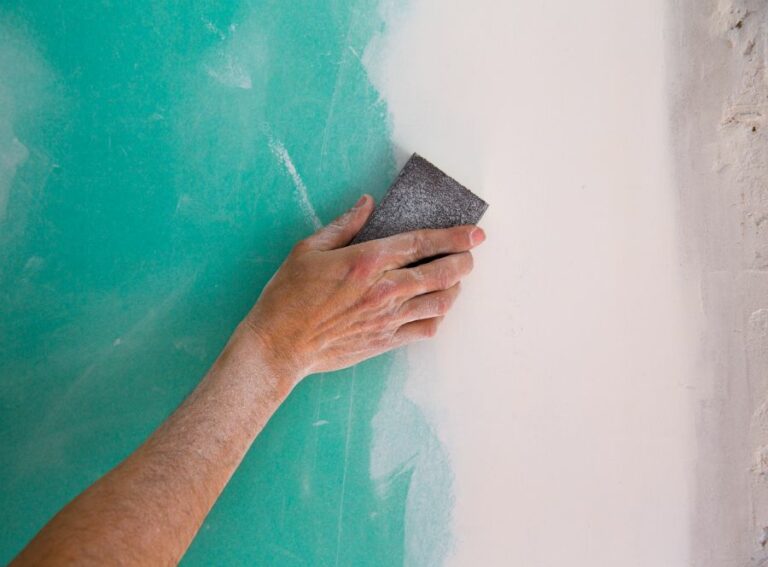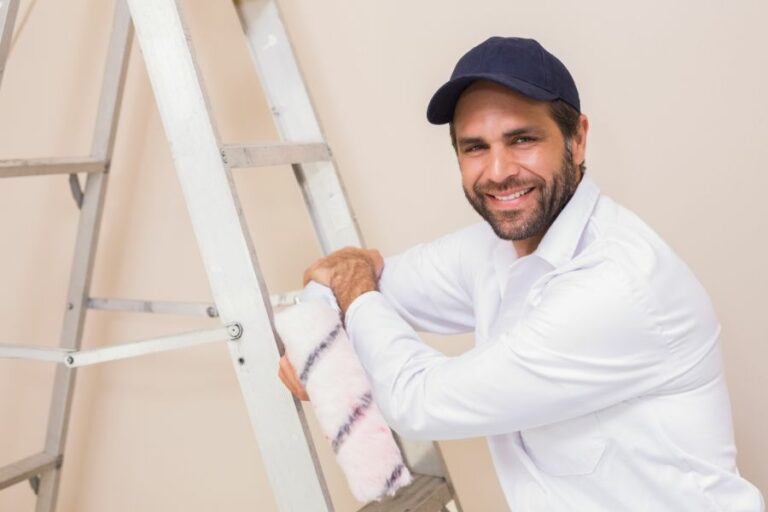Ideal Settings For Effective Surface Prep. What Pros Say
When it comes to ensuring the success of any painting or coating project, the key lies in proper surface preparation. But how do we determine the ideal settings for achieving the most effective results? Allow us to give you valuable insights and confidence in creating the perfect conditions for your next project.
Ideal settings for effective surface prep:
Optimal conditions for efficient surface preparation include a stable environment with temperatures between 50-95°F (10-35°C), 40-60% humidity levels, and clean air. Proper selection of preparation methods, such as abrasive blasting, mechanical or chemical, and adherence to safety protocols also contribute to successful surface prep.

Want to know the perfect environment to ensure an efficient surface preparation process? Continue reading as we reveal crucial factors, tips, and methods for creating ideal settings for effective surface prep. We’ve got all the vital information, don’t stop now!
Contents
- 1 Optimal Conditions for Efficient Surface Preparation
- 2 Key Considerations in Surface Prepping Process
- 3 Essential Steps to Ensure Proper Surface Prep
- 4 Understanding Surface Preparation Standards
- 5 Widely Used Technique for Preparing Surfaces
Optimal Conditions for Efficient Surface Preparation
Surface preparation is a critical step in many industries, including construction, painting, and manufacturing. Proper surface prep ensures that coatings, adhesives, or other applied elements adhere strongly and provide long-lasting, high-quality results.
• Importance of Environmental Conditions
One of the key factors to consider when preparing a surface is the environmental conditions in which the work will take place. Variables such as temperature, humidity, and air quality can greatly impact the effectiveness of surface prep and the final results.
– Temperature and Humidity Control
Ideally, surface preparation should be conducted in a stable, controlled environment, with temperatures between 50-95°F (10-35°C) and humidity levels between 40-60 percent.
These conditions enable most materials to adhere properly, dry evenly, and maintain a consistent bond. Working outside of these ranges may lead to inconsistent results and detrimental issues, such as blistering, cracking, or poor adhesion.
I recommend using fans, air conditioning units, or dehumidifiers to maximize control of the environment.
– Air Quality and Contamination
Ensuring clean air during surface prep is another key factor to success. Contaminants such as dust, grease, or other particles can interfere with adhesion and lead to poor outcomes. Employing thorough cleaning methods, proper ventilation, and clean workspaces will ensure that contaminants are minimized.
• Surface Preparation Methods
There are various methods used to properly prepare a surface, depending on the type of material and the desired finish. Selecting the right approach is essential for effective surface prep.
– Abrasive Blasting
This method uses pressurized air or water to propel abrasive particles against a surface, removing rust, paint, or other coatings and creating a clean, suitable surface for new applications.
To achieve optimal results, it is important to adjust pressure settings, abrasive materials, and nozzle sizes based on the specific surface being prepared.
I recommend referencing guidelines from professional organizations like the Society for Protective Coatings (SSPC) for industry best practices.
– Mechanical Methods
Mechanical surface prep includes techniques such as grinding, sanding, or brushing. This approach is typically used to clean and smooth surfaces, as well as remove existing coatings.
As with abrasive blasting, choosing the appropriate combination of machinery, abrasive materials, and technique is crucial. Referencing industry standards and referencing manufacturer guidelines for specific equipment will help ensure successful mechanical surface prep.
– Chemical Methods
Utilizing solvents, cleaners, or other chemical agents can also be an effective method of surface preparation. This approach works well for removing grease, oil, or other contaminants that may not be effectively removed by mechanical methods alone.
It is essential to select the right chemical agent for the material being cleaned and carefully follow instructions for proper use, handling, and disposal.
• Safety Considerations
Proper safety protocols and personal protective equipment (PPE) must be employed during all surface preparation processes. Workers should be trained in the safe use of all equipment and chemicals and provided with appropriate safety gear, such as respirators, gloves, and eye protection.
• Post-Prep Evaluation
Finally, it is crucial to assess the prepared surface’s quality after the surface prep process is complete. Common methods for evaluating surface quality include visual inspection, adhesion testing, and various industry-specific tests.
These evaluations ensure that the surface is properly prepared and ready for the next steps in the application process.
In conclusion, proper surface preparation is essential to achieving high-quality, long-lasting results in many industries.
By considering factors such as environmental conditions, selecting the appropriate preparation method, and following safety standards, you can improve the effectiveness of your surface preparation process.
Key Considerations in Surface Prepping Process
Surface preparation is a crucial step in various industries, ranging from construction to manufacturing. Proper surface preparation ensures optimal adhesion, performance, and longevity of applied coatings or materials.
• The Importance of Surface Cleanliness
Maintaining a clean surface is essential in ensuring optimal adhesion of materials. Any grease, oil, dust, or contaminants on the surface can cause premature failure of the applied coating. The most common methods of cleaning surfaces are:
- Solvent Cleaning: Effective in removing organic residues such as oil or grease. A clean rag soaked in a suitable solvent (e.g., acetone or isopropyl alcohol) is wiped across the surface.
- Detergent Cleaning: For removing inorganic residues like salts or dust, a solution of mild detergent and water, followed by thorough rinsing and drying, is used.
It’s important to remember that some surfaces may require a combination of both methods to ensure complete cleanliness.
• The Role of Surface Profile
A suitably rough surface profile is necessary for achieving optimal adhesion and coating performance. The surface profile, or surface roughness, refers to the microscopic valleys and peaks created on a surface through various methods such as abrasive blasting or mechanical treatment.
These valleys and peaks increase surface area, which, in turn, enhances adhesion.
The required surface profile depends on the nature of the applied coating or treatment:
- Thin Film Coatings: For coatings up to 5 mils in thickness (such as paints), a lower surface profile is sufficient for proper adhesion.
- Thick Film Coatings: For coatings, more than 5 mils in thickness (such as epoxy mortars), a higher surface profile is needed to ensure strong bonding.
When selecting the appropriate method for creating the desired surface profile, consider factors such as environmental and efficiency constraints.
For example, abrasive blast cleaning is a popular method for achieving an even surface profile. However, it may not be suitable for all environments due to dust or noise concerns.
• Moisture Content of the Surface
Considering the moisture content of a surface is crucial when applying certain coatings or adhesives, especially in the case of porous materials such as concrete or wood.
High moisture content can lead to issues like adhesion failure, coating delamination, or blistering. Therefore, it’s important to ensure the surface is adequately dry before application.
Assessing moisture content can be done using tools like moisture meters, which provide accurate and non-invasive measurements. In the case of concrete surfaces, the ASTM F2170 standard provides guidelines for measuring relative humidity within the material.
• Selecting the Right Surface Preparation Method
Various technology methods are available for surface preparation, each catering to different needs based on factors such as substrate material, desired surface profile, and environmental considerations. Some common methods include:
- Abrasive Blast Cleaning: Using high-pressure air to propel abrasive media, like sand or steel grit, onto the surface. This method is suitable for creating surface profiles on metals, masonry, and other surfaces.
- Mechanical Treatment: Techniques such as grinding, shot peening, or planing, which physically alter the surface profile. These methods are better suited when abrasive blast cleaning isn’t feasible.
- Chemical Treatment: The use of chemicals like acid etching or strippers to remove contaminants, laitance, or create a profile. Chemical treatments are primarily used on concrete or masonry surfaces.
When selecting the appropriate method, consider the specific requirements of your project, such as the desired surface cleanliness and profile, as well as any environmental or safety constraints.
• Quality Control and Inspection
Conducting regular quality control checks and inspections during the surface preparation process is critical in ensuring success. Some essential aspects of monitoring and inspection include:
- Cleanliness: Visually inspect the surface for any remaining contaminants, following the required cleaning methods.
- Surface Profile: Use tools like replica tapes or surface comparators to measure the achieved surface profile and verify whether it meets the required specifications.
- Moisture Content: As previously discussed, ensure the moisture content is appropriate for the specific coating or adhesive being applied.
Taking these factors into consideration and applying the appropriate preparation techniques will significantly enhance the performance and longevity of applied materials.
Proper surface preparation may require additional investment in time and resources, but it’s essential for achieving optimal results and preventing premature failures.
Essential Steps to Ensure Proper Surface Prep
Surface preparation is a critical step in any painting, coating, or bonding project. Proper surface preparation ensures adhesion, durability, and the overall success of the finished product.
• Evaluating the Surface
Before beginning any surface preparation, it is essential to evaluate the condition of the surface and identify any potential issues. This process involves:
- Inspecting for defects: Look for cracks, holes, or other imperfections that could affect adhesion and the final appearance of the coating. Repair these defects before proceeding with other methods.
- Determining the surface material: The type of surface (concrete, wood, metal, or plastic) will dictate which preparation methods are suitable.
- Checking for contamination: Identify any existing contaminants on the surface, such as grease, oil, or previously applied coatings. If necessary, consult the coating manufacturer’s guidelines for proper surface preparation.
• Cleaning the Surface
Thoroughly cleaning the surface is a vital step in the preparation process. Depending on the surface and level of contamination, there are several cleaning methods to choose from.
– Degreasing
I recommend using a suitable degreaser to remove oil, grease, and other similar contaminants from the surface. Apply according to the manufacturer’s instructions and ensure the area is well-ventilated to avoid inhaling fumes.
– Pressure Washing
High-pressure water washing is suitable for removing loose paint, dirt, and other debris from surfaces like concrete or brick. A pressure washer can be dangerous if not used correctly, so make sure to follow all safety guidelines and wear appropriate protective gear.
– Chemical Cleaning
For surfaces with heavy contamination, such as rust or existing paint, chemical cleaning methods may be required. Non-toxic, eco-friendly paint removers are available for safer use. Ensure strict adherence to safety guidelines and manufacturer’s instructions when using chemical cleaning products.
– Abrasive Cleaning
Abrasive cleaning methods, like sandblasting, can effectively remove scale, rust, and paint when chemical cleaning is insufficient. These methods use high-pressure air to propel abrasive material against the surface.
Operator safety and proper equipment use are extremely important when performing abrasive cleaning.
• Surface Profiling
Creating a profile on the surface helps improve adhesion for newly applied coatings. The appropriate degree of roughness depends on the coating material and the surface.
– Sanding
Sanding is a common method for creating a surface profile on wood and some types of metal. It involves using either hand-held sandpaper or a mechanical sander to create the desired roughness.
Be sure to wear appropriate safety gear and follow manufacturer guidelines for tool use and recommended sandpaper grits.
– Acid Etching
In some cases, acid etching can be used on concrete surfaces to achieve a rough profile. This method uses an acid solution to react with the concrete, creating a texture suitable for coatings. Care must be taken with acid etching to ensure proper surface neutralization and disposal of waste products.
– Mechanical Profiling
Mechanical methods, such as grinding or shot blasting, are also effective in creating a surface profile on materials like concrete or steel. These methods require specialized equipment and should be performed by trained professionals to ensure optimal results and safety.
• Drying the Surface
After cleaning and profiling, allow the surface to dry completely. Any moisture remaining on the surface can adversely affect the adhesion and overall performance of the applied coating.
• Final Checks and Recommendations
Before applying coatings or adhesives, perform one final inspection of the surface. Ensuring proper surface preparation helps guarantee a successful project and provides a durable, attractive, and long-lasting finished product.
In conclusion, the key steps in proper surface preparation include evaluating the surface’s condition, thorough cleaning, creating the appropriate surface profile, and allowing the surface to dry completely.
By following these steps and incorporating recommendations from industry experience, your painting, coating, or bonding project will have a solid foundation for success.
Step | Description |
|---|---|
1. | Identify the type of surface to be prepared. |
2. | Inspect the surface for any damage, dirt, or other unwanted materials and remove them if necessary. |
3. | Clean the surface thoroughly with soap and water, making sure to remove any grease, oil, or other contaminants. |
4. | Rinse the surface with clean water and allow it to dry completely. |
5. | Scraping or sanding the surface to remove any loose paint, rust, or other materials which may prevent proper adhesion of the new finish. |
6. | Apply appropriate surface treatments or fillers as needed, such as primer, caulk, or patching compound. |
7. | Sand any treated areas to create a smooth and even surface, and then clean the surface again to remove any dust or debris. |
8. | Protect any surrounding areas with painter’s tape, drop cloths, or other coverings, as needed. |
9. | Apply the chosen finish, such as paint or a protective coating, following the manufacturer’s recommendations and allowing for proper drying time between coats. |
10. | Clean up and properly dispose of or store all tools, materials, and waste. |
Understanding Surface Preparation Standards
Surface preparation is the process of preparing a surface for applying a coating, adhesive, or overlay. This is done by removing dirt, debris, and other contaminants, as well as creating a clean and rough surface for the material to adhere to.
The standard of surface preparation is an essential aspect to consider when working on any project, as it can significantly impact the longevity and performance of the coatings and coverings being applied.
• Importance of Surface Preparation Standards
Proper surface preparation is essential for the success of any coating or overlay application. A clean, adequately prepared surface ensures:
- The optimum adhesive bond between the surface and the coating or covering material.
- It has improved the performance and longevity of the applied material.
- Prevention of premature failure or delamination of the coating or overlay.
It is important to adhere to established surface preparation standards to achieve a consistent, high-quality finish. These standards define the necessary cleanliness and roughness levels for various surfaces, ensuring optimal bond strength and material performance.
• Common Surface Preparation Standards
There are several internationally recognized surface preparation standards. Some of the most widely used include the following:
– SSPC Surface Preparation Standards
The Society for Protective Coatings (SSPC) provides comprehensive surface preparation standards applicable to various industries, including protective coatings for steel, concrete, and masonry surfaces. Some of the most commonly referenced SSPC standards include:
- SSPC-SP1: Solvent cleaning: Removes oil, grease, and other contaminants using solvents.
- SSPC-SP2: Hand tool cleaning: Removes loose rust, mill scale, and other debris using hand tools.
- SSPC-SP3: Power tool cleaning: Similar to SSPC-SP2, but using power tools for more efficient cleaning.
- SSPC-SP5: White metal blast cleaning: Blast cleaning to achieve a clean, white-metal surface.
– NACE Surface Preparation Standards
The National Association of Corrosion Engineers (NACE) provides additional standards for the preparation of surfaces in corrosion control applications. NACE standards often align with the SSPC standards, with some differences tailored to specific corrosion control needs.
– ISO Surface Preparation Standards
The International Standards Organization (ISO) also offers surface preparation standards. ISO standards are often used in projects where consistency and quality requirements are of the utmost importance, such as aerospace and automotive industries.
– ICRI Surface Preparation Guidelines
The International Concrete Repair Institute (ICRI) provides guidelines for the preparation of concrete surfaces. These guidelines focus on surface roughness, as measured with the ICRI Concrete Surface Profile (CSP) chipsets.
The ICRI guidelines are widely used in the concrete repair, restoration, and overlay industries.
• Recommendations for Proper Surface Preparation
- Choose the right standard: Evaluate the requirements of your project and select the appropriate surface preparation standard based on the material you are applying and the industry specifications.
- Use appropriate tools and equipment: Ensure you are using the correct tools and equipment, based on the selected standard, for thorough cleaning and preparation of the surface.
- Follow proper safety protocols: Surface preparation can involve hazardous chemicals, high-pressure equipment, and other risks. Always adhere to the safety guidelines and wear appropriate personal protective equipment (PPE).
- Inspect the surface before and after preparation: Before starting the surface preparation, inspect the surface for any visible contaminants. After the preparation is complete, ensure that the surface meets the cleanliness and roughness requirements specified by the standard.
- Document the process: Keep accurate records of the surface preparation process, including the standard used, equipment and materials employed, and inspection results. This documentation can be beneficial for quality control and future maintenance.
• Conclusion
Surface preparation is a critical step in the application of coatings, adhesives, and overlays. By adhering to established surface preparation standards and following recommended practices, you can ensure the long-lasting performance and durability of your applied materials.
For further information on the methods and requirements of various surface preparation standards, please refer to the SSPC, NACE, ISO, and ICRI websites.
Widely Used Technique for Preparing Surfaces
As an experienced professional in the field of surface preparation, I can confidently say that abrasive blasting is the most common technique used for preparing surfaces. This technique is essential in numerous industries such as construction, automotive, and marine.
• An Overview of Abrasive Blasting
Abrasive blasting, also known as sandblasting, is the process of forcibly propelling a stream of abrasive material against a surface under high pressure. This action removes contaminants, roughens or smoothens the surface, and can shape the material.
Abrasive blasting is crucial for improving the adhesion of coatings, paint, or other treatments to the surface.
– Types of Abrasive Blasting
There are several types of abrasive blasting based on the media used and the method of propelling it. Here are the most common types:
- Dry Blasting: In this method, compressed air is used to propel the abrasive particles. It is usually carried out in a blast cabinet or an enclosed environment to contain the dust.
- Wet Blasting: Water is mixed with the abrasive media in this technique, which helps reduce dust and airborne contaminants. The process can be carried out using either a slurry or a high-pressure water jet.
- Vacuum Blasting: Also known as dustless blasting, vacuum blasting employs a system that captures and filters dust and abrasive particles. This method is ideal for sensitive areas or when dust control is vital.
- Sponge Blasting: Sponge blasting uses sponge media, which consists of polyurethane foam particles coated with abrasives like aluminum oxide or steel grit. The sponge flattens upon impact, reducing dust and allowing for easier waste containment.
– Popular Abrasives
Choosing the right abrasive depends on factors like surface material, required finish, and environmental concerns. Some common abrasives include:
- Sand
- Steel shot or grit
- Glass beads
- Aluminum oxide
- Garnet
- Walnut shell
- Plastic media
• Advantages of Abrasive Blasting
Some benefits of using abrasive blasting for surface preparation are:
- Cleaning Capability: Abrasive blasting effectively removes rust, paint, scale, and other contaminants from surfaces, promoting better adhesion of coatings.
- Versatility: By adjusting the type and size of the media, the pressure, and other factors, the process can achieve various surface profiles or texturing.
- Time-Saving: Abrasive blasting is a fast and efficient method to clean and prepare surfaces compared to manual methods such as wire brushing or sanding.
- Eco-friendly: Using eco-friendly media like sponges or recycled glass beads can help minimize waste and reduce environmental impact.
• Choosing the Right Equipment
Selecting the appropriate abrasive blasting equipment is vital for achieving optimal results. Here are some factors to consider:
- Blast Pot: Choose a blast pot suitable for the size of the project, media type, and required pressure.
- Blasting Nozzle: Select the appropriate nozzle size and material (such as ceramic, tungsten carbide, or boron carbide) based on the media used and desired production rate.
- Air Compressor: A sufficient air supply is critical. Consider the compressor’s capacity, pressure rating, and additional accessories like air dryers and separators.
- Media Recovery System: For larger projects, a media recovery system helps reduce waste and increases efficiency.
- Safety Equipment: Ensure operators have proper protective gear, including helmets, gloves, coveralls, boots, and hearing protection.
• Recommendations Based on Experience
Here are some recommendations for a successful abrasive blasting project:
- Always perform a test blast on a sample surface to determine the correct media type, size, and pressure necessary for the desired result.
- Check the compatibility of the paint or coating with the prepared surface.
- Control and prevent the risk of moisture in the air supply, as it can cause flash rusting or clumping of media.
- Comply with local regulations and environmental laws on dust control and abrasive media disposal.
- Regularly inspect and maintain blast equipment to ensure efficient and safe operation.
In conclusion, abrasive blasting is the most common surface preparation technique due to its versatility, efficiency, and effectiveness.
By understanding the process, choosing the right equipment, and following best practices, one can ensure proper surface preparation for a successful coating or treatment application.
For more information on surface preparation and abrasive blasting, visit the SSPC website, a non-profit organization dedicated to the industry’s standards, education, and certification.







